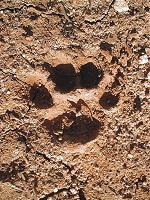Pax Nortona – A Blog by Joel Sax
From the Land of the Lost Blunderbuss
Home - Travel - Hikes and Trails - Felis Concolor at Whiting Wilderness 4
Felis Concolor at Whiting Wilderness 4
Posted on March 11, 2004 in Hikes and Trails Mountain Lions Nature Neighborhood
 My friend George joked that if we went ahead with a plan to hold a poetry reading at Whiting Ranch Wilderness, he’d bring along a copy of Blake and read The Tyger, ending with the cry “Please don’t eat us!”
My friend George joked that if we went ahead with a plan to hold a poetry reading at Whiting Ranch Wilderness, he’d bring along a copy of Blake and read The Tyger, ending with the cry “Please don’t eat us!”
Most people, including myself, expected that it would be some time before a new cat moved into our area.

My friend Donna, for example, comforted herself by saying that mountains lions are territorial, so it would take a couple of years before a new one moves into the region. I was inclined to agree.
On Tuesday, I went for a walk along the Sage Scrub Trail. There, preserved in the hardened mud along that mountain biker-eroded canyon, I saw a series of about ten tracks. A big cat had come up that steep path, using the trail as a sure route through the cactus, perhaps heading to the Upper Pond.
The bikers who joy-rided down the precipitous slope, following the rut laid out by too many predecessors, did not notice the sign peppering the left side of the trail. I called the rangers, raised a cairn, warned those I could. I continued my walk through Sleepy Hollow, stopping to take photos but only when I stood in a clearing and looked around first. I saw manroot blossoms; cardoon priming their artichoke grenades; the pink blossoms of lemonade sumac; scrub oak with galls that looked like late autumn’s apples; and a belligerant yellow escapee from the housing tract overlooking the Sage Scrub Trail that sent its rocket blooms flying from scatterings of olive-leaf-green foilage. And ten yards below the point where the Sleepy Hollow Trail rejoins Whiting Road, I saw another series of tracks on the left side, belonging to a smaller cat.
Population pressure must be such that the lions have wasted no time moving into good deer hunting grounds. They have filled the niche.
Due to the popularity of this topic, I’ve added a “Mountain Lions” category.

